
Savona is a seaport and comune in the west part of the northern Italian region of Liguria, capital of the Province of Savona, in the Riviera di Ponente on the Mediterranean Sea. Savona is the main center of the Italian Riviera.

The Basilica of Saint Mary of the Altar in Heaven is a titular basilica and conventual church of the Franciscan Convent of Aracoeli located the highest summit of the Capitoline Hill in Rome, Italy. From 1250-1798 it was the headquarters of the General Curia of the Order of Friars Minor as well as being one of the city's principal civic churches. It is still the designated church of the city council of Rome, which uses the ancient title of Senatus Populusque Romanus. The present cardinal priest of the Titulus Sanctae Mariae de Aracoeli is Salvatore De Giorgi.
Bernardo Castello (1557–1629) was an Italian painter of the late-Mannerist style, active mainly in Genoa and Liguria. He is mainly known as a portrait and historical painter.
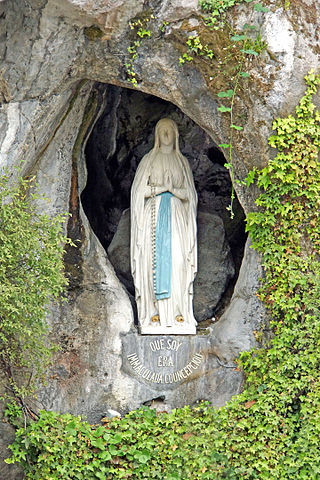
Our Lady of Lourdes is a title of the Virgin Mary. She is venerated under this title by the Roman Catholic Church due to her apparitions that occurred in Lourdes, France. The first apparition of 11 February 1858, of which Bernadette Soubirous told her mother that a "Lady" spoke to her in the cave of Massabielle while she was gathering firewood with her sister and a friend. Similar apparitions of the "Lady" were reported on 18 occasions that year, until the climax revelation in which she introduced herself as: "the Immaculate Conception". On 18 January 1862, the local Bishop of Tarbes Bertrand-Sévère Laurence endorsed the veneration of the Blessed Virgin Mary in Lourdes.
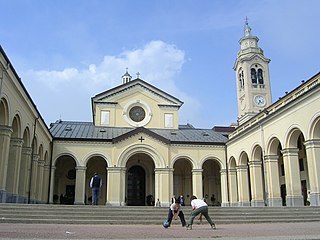
Ceranesi is a comune (municipality) in the Metropolitan City of Genoa in the Italian region Liguria, located about 11 kilometres (7 mi) northwest of Genoa.

The Sanctuary of Nostra Signora della Misericordia is a church and surrounding buildings located some six kilometers from the center of Savona, Liguria, northern Italy.

Bolzaneto is a quarter of the city of Genoa, in northwest Italy, and is part of the Municipality Valpolcevera of Genoa.
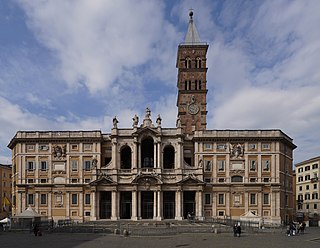
Catholic Marian churches are religious buildings dedicated to the veneration of the Blessed Virgin Mary. These churches were built throughout the history of the Catholic Church, and today they can be found on every continent including Antarctica. The history of Marian church architecture tells the unfolding story of the development of Catholic Mariology.

Monte Figogna is a mountain in Liguria, northern Italy, part of the Ligurian Apennines. It is located in the Municipality of Ceranesi, about 20 km from the city of Genoa. It lies at an altitude of 804 metres. In Ligurian, the mountain is called Monte Fighêugna.

The Pontifical Shrine of the Blessed Virgin of the Rosary of Pompei is a Catholic cathedral, Marian pontifical shrine, and Pontifical minor basilica commissioned and co-founded by Bartolo Longo and his wife the Countess Mariana di Fusco, located in Pompei, Italy. It is the see of the Territorial Prelature of Pompei.

Santa Maria delle Vigne is a Roman Catholic basilica church in Genoa, Italy. It was built in the 10th century. The main altar was completed in 1730 by Giacomo Antonio Ponsonelli. The church is also the final resting place of the leading early Italian composer Alessandro Stradella, who was murdered in 1682.
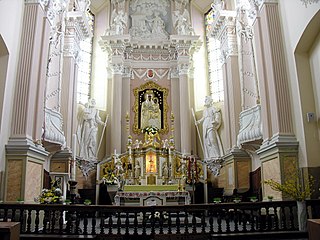
Our Lady of Šiluva is Roman Catholic image of the Blessed Virgin Mary venerated at the Basilica of the Nativity of the Blessed Virgin Mary, Šiluva shrine in Lithuania. The patriotic icon is highly venerated in Lithuania and is often called Lithuania's greatest treasure.

The Church of Saint Anne, with the adjacent convent and pharmacy of the Discalced Carmelites, is a Roman Catholic church located in the residential quarter of Castelletto in Genoa, Liguria, north-western Italy. The village - now surrounded by the city - is still intact, with its leafy trees, cobbled walkways and open views from Salita Bachernia over the Gulf of Genoa, the harbor and the Old City.

The basilica sanctuary of Our Lady of Montallegro is a place of Catholic worship located in the hamlet of Montallegro in the municipality of Rapallo, in the metropolitan city of Genoa.

The Basilica della Madonna Consolata is a Roman Catholic minor basilica and Marian shrine in central Turin, Piedmont, Italy. Located on the intersection of Via Consolata and Via Carlo Ignazio Giulio, the shrine is dedicated to the Blessed Virgin Mary under the title of Our Lady of Consolation.

The Nostra Signora della Brughiera is a sanctuary devoted to the Virgin Mary in the town of Trivero in northern Italy.
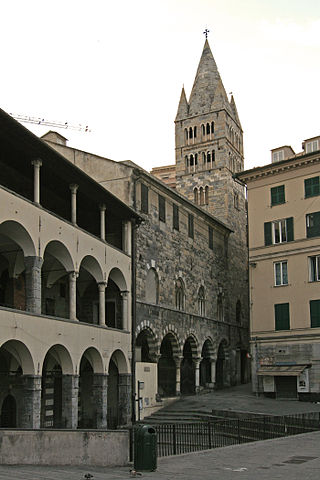
Prè is a neighbourhood in the old town of the Italian city of Genoa. It was one of the six sestieri of ancient Genoa. At present it is part of the Genoa's city I Municipio. Located close to the old harbour, it is likely the best-known neighbourhood of the old town of Genoa.
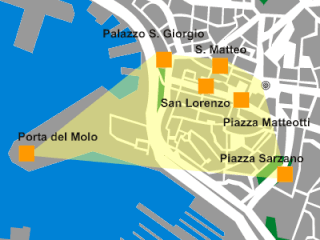
Molo is a neighbourhood in the old town of the Italian city of Genoa. It was one of the six sestieri of ancient Genoa. At present is part of the Genoa's city Municipio I.























